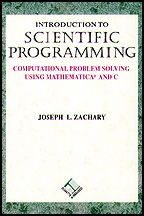Introduction to Scientific Programming was developed over a
period of three years for use in teaching a course in scientific computing
to beginning science and engineering students at the University of Utah.
In conventional science and engineering degree programs, computation is
commonly treated as a narrow technical tool to be studied and
applied in isolation from the traditional topics of the discipline.
Many students go through their degree programs without ever using computation
in any significant way.
Introduction to Scientific Programming was designed to
encourage the integration of computation into the science and
engineering curricula. This textbook is ideal for a course whose goal
is to teach introductory programming while simultaneously preparing
students to immediately exploit the broad power of modern computing in
their science and engineering courses. This textbook has at least four
distinguishing features:
- A symbolic mathematics package (Mathematica) is used in combination with a
conventional programming language (C).
- Programming concepts are taught in parallel with a computational
science problem-solving methodology.
- A variety of computational problems are used from the breadth of
science and engineering to interest students and establish the relevance
of the computational problem-solving approach.
- An extensive suite of interactive, on-line laboratory materials
have been developed. These include HTML-based tutorials enhanced with
Java applets, Mathematica notebooks, and C programs.
Introduction to Scientific Programming is organized into a
series of short, focused chapters. Each chapter begins by introducing a
problem and then guiding the student through its solution. The computational
techniques needed to solve the problem are developed as necessary. In this
way, the motivation for learning the computing is always apparent. This
deliberate problem-orientation is one of the defining characteristics of
this book. In most other books that claim to be problem-oriented the
examples are typically presented after the computing.
Understanding the computational problem-solving process is at least as
important as understanding how to write code. Each of the chapters focuses
on solving the motivating problem via the following approach:
 Problem.
Clearly and unambiguously identify the problem to be solved.
Problem.
Clearly and unambiguously identify the problem to be solved.
 Model.
Use simplification and abstraction to arrive at a mathematical
model for the problem.
Model.
Use simplification and abstraction to arrive at a mathematical
model for the problem.
 Method.
Identify a computational method for solving the model.
Method.
Identify a computational method for solving the model.
 Implementation.
Implement the method in the appropriate language.
Implementation.
Implement the method in the appropriate language.
 Assessment.
Concurrently with the other four steps, actively assess the
problem-solving process to identify mistakes and unwarranted assumptions.
Assessment.
Concurrently with the other four steps, actively assess the
problem-solving process to identify mistakes and unwarranted assumptions.
![]() Problem.
Clearly and unambiguously identify the problem to be solved.
Problem.
Clearly and unambiguously identify the problem to be solved.![]() Model.
Use simplification and abstraction to arrive at a mathematical
model for the problem.
Model.
Use simplification and abstraction to arrive at a mathematical
model for the problem.![]() Method.
Identify a computational method for solving the model.
Method.
Identify a computational method for solving the model.![]() Implementation.
Implement the method in the appropriate language.
Implementation.
Implement the method in the appropriate language.![]() Assessment.
Concurrently with the other four steps, actively assess the
problem-solving process to identify mistakes and unwarranted assumptions.
Assessment.
Concurrently with the other four steps, actively assess the
problem-solving process to identify mistakes and unwarranted assumptions.